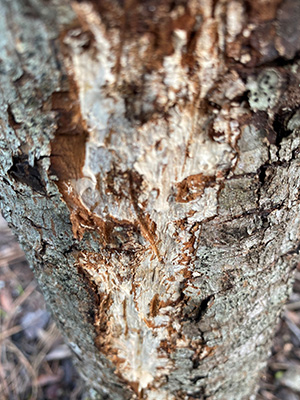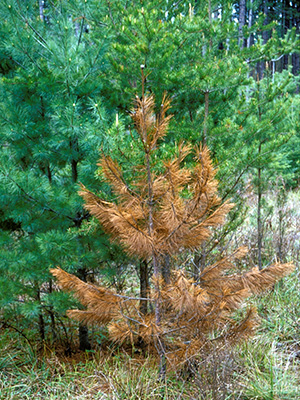Armillaria Root Rot
Have you ever noticed a tree or shrub that is wilting, with sparse, dry and shriveled leaves? Or have you come across a tree or shrub that seems to have turned brown overnight?
The culprit might be Armillaria root rot, also called mushroom root rot. This disease is caused by a genus of fungi, Armillaria spp., that infests the inside of a plant and prevents it from properly absorbing water. Here in Florida, Armillaria tabescens is the most common species infecting trees and shrubs. Plants that are particularly susceptible include turkey oak, laurel oak, bottlebrush, azalea, ligustrum, camelia, citrus, peach and loquat.
The fungus feeds on dead and living roots, and causes the living ones to decay, weaken and even die. Armillaria can spread to new areas via spore dispersal, but most commonly will infect new plants by spreading underground via root-like cords (rhizomorphs) to nearby plant roots. This allows the fungus to expand and colonize new areas. For this reason, you might first notice one infected plant, followed by the surrounding plants.
Quick action is required to prevent Armillaria root rot from spreading, but first you must know how to recognize the signs and symptoms. The first clue is a decline in the health of your plant, which shows up as dead branches, branch or trunk failure, dieback or stunted growth, and fading, wilting or thinning foliage. Sometimes these signs are so subtle that you may not notice it until the tree or shrub is brown with the dead leaves still attached to the tree. If you peel off some bark from the stems, roots or base of the trunk, you might see flat, white sheets of fungal growth clinging to the wood.
Unfortunately, by the time you see this decline, the disease has already infected the plant. Next, you might see clusters of yellow to honey-colored mushrooms, which are the fruiting bodies of the fungi. These mushrooms can emerge from infected tree roots under the turf, or near the bases of infected trees and shrubs. In Florida, they usually emerge during the cooler temperatures of fall and winter (and occasionally in late spring), when there’s enough moisture.

What to Do
Most of the time in Florida, Armillaria root rot is a secondary condition that will affect an already-stressed shrub or tree. A plant that is older or has been battling drought, flooding, disease, pests, or improper pruning or fertilization can be more susceptible to the fungus. Therefore, the best way to prevent infection is to keep your trees and shrubs strong and healthy.
To maintain a healthy landscape, make sure to engage in proper pruning, fertilization, irrigation and pest management practices. Having a diverse number of plant species in your yard will further protect your trees and shrubs from Armillaria. You should also make a practice of disinfecting your gardening tools to prevent the spread of the fungus.
Since symptoms of Armillaria root rot generally don’t appear until the tree has already been infected (it can take as long as one to three years), it is generally impossible to save the plant. In this case you should remove the infected plant, including the roots. Since the fungus can live in the remaining dead roots and stumps for years, the entire plant must be removed.
If the Armillaria-infected plant is one shrub in a row of shrubs, replacing it may be tricky. While many gardeners would like to simply replace it with the same kind of plant, it increases the chance that the new plant will become infected. You may also find that the other plants in that area are affected by the fungus later on, so you might need to pull out all the potentially infected shrubs in the surrounding area. It’s a tough choice—one that could be costly and time-consuming.
If you would like to replant in the area of removal, consider choosing a plant that’s resistant to the fungus, as Armillaria can continue to live in the soil.

With variable and extreme weather patterns, we expect to see the effects of Armillaria to be exacerbated and cases to increase. Choosing trees and shrubs that are resilient and adapted to the local conditions, such as Florida-Friendly options, should be considered for planting to decrease chances of infection1.
Armillaria root rot is a deadly disease that should be addressed as soon as possible. While there are no fungicides available to treat the plant, rapid identification of Armillaria and subsequent plant removal is key. For more information or help with prognosis, contact your county UF/IFAS Extension office.
Also on Gardening Solutions
More from UF/IFAS
- Armillaria Root Rot (Also known as Mushroom Root Rot, Shoestring Root Rot, Honey Mushroom Rot)–Florida Online Journals
- Armillaria Root Rot–Florida 4-H Forest Ecology
Reference
- Kim, Mee-Sook; Heinzelmann, Renate; Labbe, Frederic; Ota, Yuko; Elías-Roman, Ruben Damian; Pildain, María Belen; Stewart, Jane E.; Woodward, Stephen; Klopfenstein, Ned B.2022. Armillaria root diseases of diverse trees in wide-spread global regions [Chapter 20]. Forest Microbiology. 2: 361-378. https://doi.org/10.1016/B978-0-323-85042-1.00004-5.

